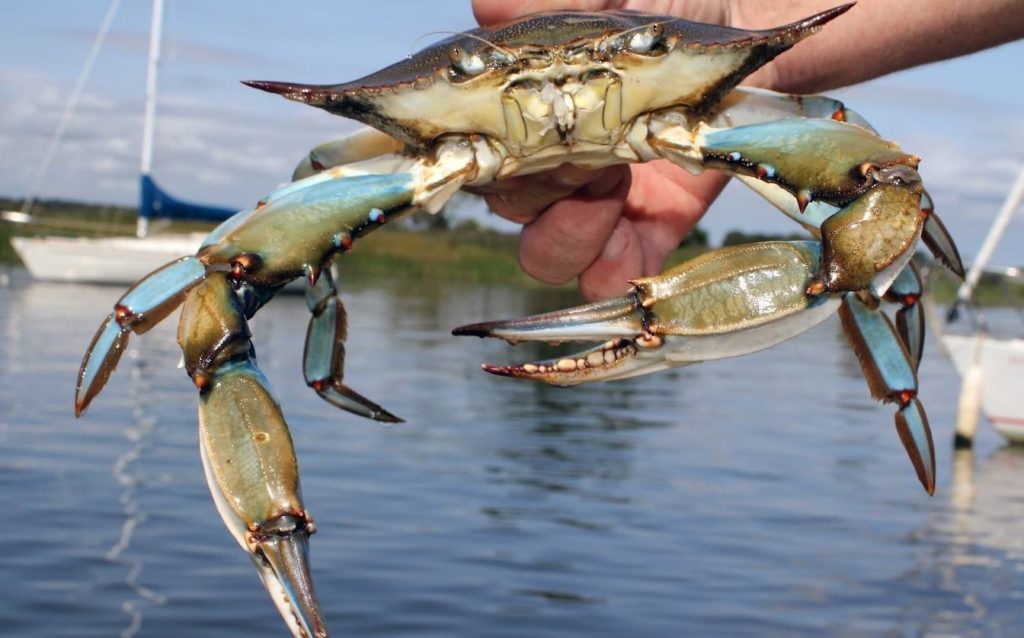There are few better ways to spend a summer day than anchored in the back bay, kite string between your fingers, waiting for the telltale vibrations of a big blue crab ripping away at your bait. As you slowly pull the line toward you, the netter stands poised, ready to strike, and as the big jimmy comes into view, a swift, smooth stroke puts the now furious crab skittering across the floor of the wooden rental boat. Hours later, the same crab, covered in bay spices and dunked in drawn butter, puts an exclamation point on a perfect summer day.
Young or old, male or female, old salt or greenhorn, crabbing is an activity that can be enjoyed by anyone who loves spending time on the water. While done easily from shore, crabbing is at its best aboard a boat in the back bays.
By following these simple techniques on how to crab, you may even bring home a meal or two at the end of the day!
Crabs move in and out with the tides just like the fish do. Make sure the depth is no deeper than 10 feet. Getting away from boat traffic and the summer rush to find a quiet spot is key. Locate creeks that are no deeper than 10 feet and no wider than 30 yards, and you will find the blue claws. Creeks tend to funnel the crabs from one place to another, usually from one section of a bay to another. When setting up in a creek, you are placing yourself and your baits in the blue claw expressway. This way, all the passing crabs will move near your baits, which will often prove impossible for them to resist.
Crabbing in areas where the creek bends sharply forces the crabs to congregate and gives them a few extra minutes to grab onto that fresh fish you have dangling over the side. Be sure that every trap or handline goes over the same side of the boat. Be sure to send out your hand lines on the down-current side of the boat. Crabs will almost always let go if your handline swings under the boat while you retrieve them.
Once you’ve found your creek, for the best results, you’ll want to double anchor, setting one anchor off the bow and one off the stern. This will keep the boat, and your baits, still for the entire trip. Moving baits will deter crabs and not attract them. You want to place your boat perpendicular to the creek channel. This way, the front, middle, and back of the boat cover most, if not all of the creek and the crabs have to encounter one of the baits as they swim past. Make sure both anchors are set with enough scope out and that the boat has very little side-to-side motion. If you notice one side of the creek is deeper, set up over that side, as the largest jimmies will favor the deeper, cooler waters on their way to lunch.
There is no shortage of ways to catch crabs, from large commercial Chesapeake Bay traps to collapsible traps and even pull nets, but the one way that is often successful, and most enjoyable, is the handline. The handline requires a bit of finesse and technique. You must give the crab some credit – they are not as senseless as most would think. They can feel the slightest tension in any moving current and will not remain attached to the baits if the handline is pulled up too fast.
A handline consists of a spool of string, either yarn or kite string, a curtain hook, and a lead weight. The curtain hooks work nicely because they easily accommodate the string, the bait, and the weight. Each spool of a line should contain anywhere from 30 to 50 feet of line depending on the depth and speed of the water current, a 2- to 4-ounce pyramid-style sinker, and the curtain hook. The pointed end of the hook will attach the bait by pushing right through the eye of the fish. Then, close the hook, and you are ready to send it down to the bottom. There are also commercially made handlines and bait holders available at most tackle shops.
The way to fish these hardlines is simple, though it requires some patience. The key is picking the bait off the bottom slowly so the crabs do not jump off before reaching the surface, where they can be netted. Wait three to five minutes before pulling up each line. When I first started crabbing around the age of three, I retrieved the line finger over finger until the bait and crab were close enough to net. Many times, the crabs will abandon the bait right as it is lifted off the bottom. On a bright sunny day, be ready to net the crabs earlier than normal as sometimes the largest jimmies will jump off as they are brought closer to the light.
While aged chicken has been a long-time crabbing favorite, fresh fish racks are often preferred. Another popular bait is bunker. These fish make one of the oiliest and smelliest baits out there. It does fall apart rather quickly and the crabs do not have as much room to hang on compared to a fluke rack – especially if the crabs are running so well you can land them three or four at a time! If you cannot find any other type of fresh fish, go with frozen bunker but be sure to pull up those lines nice and slow.
Following these simple techniques will produce more crabs, and crab dinners, for you and your friends this summer. So call your Dockmaster at Carefree Boat Club and schedule a boat, bring some snacks and enjoy one of the greatest summer pastimes in our region.

